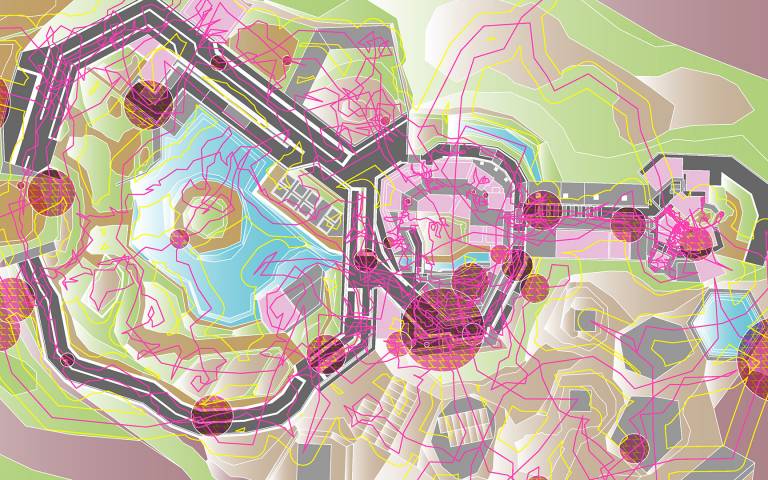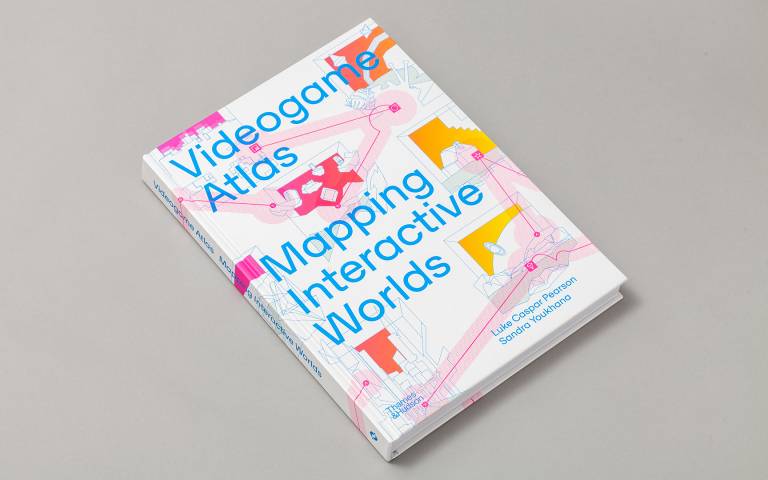Bartlett Tutors Launch New Book On Videogame Worldbuilding
1 November 2022
Luke Caspar Pearson and Sandra Youkhana’s new book 'Videogame Atlas: Mapping Interactive Worlds' (Thames and Hudson) applies an architectural eye to twelve popular video game worlds.

More than ever, video games offer players vast and sophisticated virtual worlds to immerse themselves in. The complexity of this world-building mirrors the vision and skill of architectural designers in creating terrains that feel real and compelling to the gamer, something that Luke Pearson and Sandra Youkhana have been exploring in Videogame Urbanism, their research cluster within The Bartlett’s Urban Design MArch programme. Now in a new large-format book, the first they have published together, they gather worlds, perspectives and architectural theory to examine how these virtual worlds are conceived, built and inhabited.

Through panoramic maps, intricate exploded diagrams and illustrations all produced by Luke and Sandra, Videogame Atlas: Mapping Interactive Worlds presents new perspectives on twelve popular videogame worlds. Taking influence from late-20th-century experimental architecture publications, this large-format book offers a playful, detailed new way of seeing these beloved virtual environments using the practices and thinking behind architectural theory in the real built environment. Luke and Sandra created the book to appeal to anyone with an interest in the relationship between architecture and game design. For architects the book examines similarities between the design of game environments and how buildings and cities are designed, while gamers and game designers will learn how the design of these environments parallels long-held principles and ideas that have also guided architectural design.
Across over 400 illustrations and twelve essays, the ‘fourth wall’ of familiar virtual worlds are breached and deconstructed as complex urban landscapes. The book covers a range of titles, from AAA to independent games, with chapters on Assassin’s Creed: Unity, Cities: Skylines, Dark Souls, Death Stranding, Dwarf Fortress, Final Fantasy VII (+Remake), Fortnite, Katamari Damacy, Minecraft, No Man’s Sky, Persona 5 and Stardew Valley.
Recalling the inspiration for the book, Luke said,
“We wanted to create a book that addresses videogame worlds because they are virtual spaces that millions of people travel to each day, with their own cultures, societies and economies. For us it is important for architects to understand the impact of game worlds on how the public experience space, but also to recognise that the history and theory of architecture can also allow us to interpret game worlds in new ways.
Our use of drawing is key to revealing these insights and putting them into a graphic language that many different readers can understand."
Videogame Atlas: Mapping Interactive Worlds is published by Thames & Hudson, alongside a special edition through Read-Only Memory/Volume containing a triptych of game-inspired prints.
Luke Caspar Pearson is Co-Director of Architecture BSc (ARB/RIBA Part 1) and the newly launched Cinematic and Videogame Architecture MArch at The Bartlett, and an Associate Professor. Sandra Youkhana is a lecturer (teaching) at The Bartlett, an architect and a PhD candidate in Architectural Design. Together they teach Urban Design MArch’s Research Cluster 12 (‘Videogame Urbanism’) and lead an architectural design studio, You+Pea. You+Pea’s game-based works have been exhibited at galleries including the Victoria & Albert Museum, Architekturzentrum Wien, Vienna and at EGX London, the UK’s leading gaming expo. Sandra and Luke have also written on the relationship between games and architecture for journals including Perspecta: The Yale Architecture Journal (MIT Press, 2022) and books such as Design Studio: Intelligent Control (RIBA Books, 2021).
Luke is also the author of Re-Imagining the Avant-Garde: Revisiting the architecture of the 1960s and 70s (Wiley, 2019) and Drawing Futures: Speculations in contemporary drawing for art and architecture (UCL Press, 2016).
‘Videogame Atlas: Mapping Interactive Worlds’ is released on 15 November.
More information
- Pre-order ‘Videogame Atlas: Mapping Interactive Worlds’ at Thames and Hudson
- Visit You+Pea’s website
- Find out more about Cinematic and Videogame Architecture MArch
- Find out more about Urban Design MArch
Lead image: Map showing player routes in the game Katamari Damacy (Namco, 2004) from 'Videogame Atlas' by Luke Caspar Pearson and Sandra Youkhana
Image 2: Cover of Videogame Atlas. Photograph by Studio SP
 Close
Close

